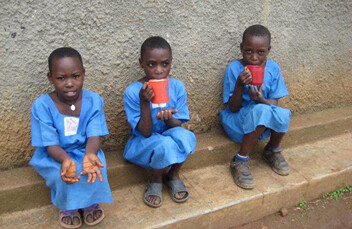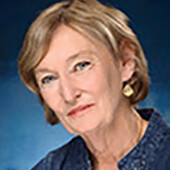It is still dark at 5:30 a.m. when 12-year-old Lily rises from her floor mat, delicately slipping on her plastic sandals to start her chores. Her family's two-room home smells of wet earth and smoke. She moves quietly out the door, picking up a plastic water container that is nearly as big as she is. She heads off to the local water source, sometimes little more than a sorry brown pool, more than a kilometer from home at the base of a steep hill. Fetching the family's water is top priority before she can head to school. Hopefully there will be time for a cup of tea—all the nourishment she'll get until dinnertime.
Lily lives in a western region of Uganda where stunted growth and malnutrition affect more than 40 percent of local children. Meals typically consist of fried mashed bananas and offer little in the way of variety or vitamins and nutrients. Luckily, however, help is on the way for Lily, thanks to the Kasiisi Porridge Project (KPP) and its plans to provide a daily cup of maize-flour porridge to all the children at her school.
The Kasiisi Porridge Project is the brainchild of an inspired British linguist and educator, Kate Wrangham-Briggs, who seized upon the idea after a 2005 visit to her twin brother's chimpanzee research site in Western Uganda. After learning that children at local schools often consume only a single daily meal due to regional poverty, Kate took on the task of improving the situation. Maize-based porridge offers an affordable and effective means of feeding 1,500 children at two local schools.
The benefits for the school children are manifold. Not only are they better able to withstand the long school day without falling asleep from hunger, but many poor families now encourage their children to attend the free primary school for the entire day and with fewer absences. Ultimately, the porridge leads to better academic performance for many students and a greater likelihood of going on to secondary school. In turn, students with higher levels of education are more likely to find work and, in the case of girls, to avoid early teen pregnancy, early marriage, and a life in domestic service, all too often involving sexual abuse. Overall, a few mugs of porridge has an impact far beyond what Kate and her team had ever imagined.
How It Started
A 1996 vacation to Uganda to visit Kate's brother, Harvard professor Richard Wrangham, and his wife, Elizabeth Ross, set the stage for the work that followed. Kate and her sister-in-law visited a weathered primary school near Kibale National Park where Wrangham was studying wild chimpanzees. The visit had a dramatic impact on both of them. The children were studying in classrooms so rickety that they had to be evacuated during high winds. Children in early grades were taught in classrooms with upwards of 150 students and the school had been overwhelmed with new pupils when the Ugandan government declared primary education would be universally provided.
The school visit led Ross and Wrangham to establish The Kasiisi Project to support education, health, and wildlife conservation in local primary schools. The Project constructed several new schools and rebuilt others, adding dormitories, libraries, staff rooms, and power. The Project grew quickly, to the point where today it also offers secondary school scholarships, teacher training, preschool education, and computer, health, and conservation education.
But it was another visit to Kasiisi by Kate in 2005 that provided the impetus for the Kasiisi Project's next big undertaking. While visiting the local primary school, Kate asked to attend one of the classes. As Kate tells the story:
Lydia, the headmistress, said it would be okay for me to attend, but at the moment it was lunch time.
"Fine," I said. "Where do they have lunch? I'll join them."
Lydia replied: "I said lunch 'time.' They don't actually HAVE LUNCH! They play football."
That interaction set in motion Kate's mission to provide daily porridge for 1,250 students.

In a brief five years, the Kasiisi Porridge Project has created two school kitchens, built latrines and water tanks, hired cooks, and found donations to provide porridge for upper division students at two of five primary schools located within 5 km of Kibale National Park. The work has depended not just on contributions from U.K. schools, clubs, churches, businesses, and individuals, but also on huge volunteer efforts.
One of the biggest boosts came unexpectedly when Kate was receiving legal assistance to register KPP as a charity. Lawyers at the London firm of Cadwalader, Wickersham & Taft LLP were impressed and invited her to bid for corporate sponsorship. The Project was selected from a shortlist of 12 candidates, and soon Kate found herself Uganda-bound once again, leading a team of six young Cadwalader lawyers, along with 5 of her own trustees, on a two-week service trip that would ultimately result in the resources needed to build the much-needed porridge kitchens.
Nowhere a Greater Need
Few places in the world have a greater need for KPP's services than the Kabarole District where the schools are located. Uganda's children have one of the highest rates of stunted growth in all of sub-Saharan Africa—and Kabarole District has an even higher rate. Among children under five, 41.6 percent have stunted growth as a result of poor diet or disease, and many local children suffer both from calorie malnutrition (an absence of sufficient calories) and protein malnutrition (the absence of a quality diet to ensure needed vitamins and protein).
Although Kibale is one of the most fertile areas of Uganda, high rates of malnutrition result from the region's immense poverty and limited education. Compounding these challenges is the large number of orphans. In the two Kasiisi schools, 25 percent of children have lost at least one parent, usually to AIDS, and a significant number of children themselves are HIV positive. For those lucky enough to have access to drugs, good nutrition is vital for them to be effective.
So is porridge a nutritional solution? Technically, porridge is any cooked grain-based cereal to which milk or water is added to create a thick soup, so it is not surprising that some forms of porridge are more nutritious than others. Although no porridge by itself completely satisfies nutritional needs, it is nevertheless generally a healthy source of calories and sustenance and an international dietary mainstay. Scotland and Wales have long prided themselves on a tradition of oat-based porridge—indeed the 19th annual World Porridge Making Championships will take place in the Scottish Highland village of Carrbridge in October 2012! Even the United States has its own common porridge, oatmeal, that was popularized by the Quaker Oats Company. Oat-based porridges are known to have been a staple of the human diet, even as far back as 5,000 years ago.
Researchers have found that the Kaisiisi Porridge Project has achieved important nutritional gains. Analyses show that their lunch program has increased school enrollment, particularly for girls, reduced school dropout rates, and produced taller and more normal-weight children. A separate study by a Harvard student has compared energy levels of children at the Kasiisi schools receiving lunch with those from control schools. The results show that children eating school lunches have over 20 percent higher energy levels than those who do not—the natural presumption being that well-fed students have greater opportunity for active classroom involvement and academic success.

KPP has also tested an enriched banana-based porridge. Although bananas are of limited nutritional value by themselves, nutrients and vitamins can be easily mixed into them. Whether this porridge will ultimately replace the maize-based porridge remains to be seen, but in the meantime, KPP is working to expand the porridge meals to include the younger children, who currently finish their school day at noon. KPP is also in the early stages of its next phase which, if successful, will not only provide students with more complete diets but also carry KPP into the future.
Phase II: Building a Cutting-Edge Farm
KPP has accomplished big gains in just a few short years, but now it is tackling the even greater challenge of making itself self-sustaining so that future generations of school children will continue to benefit, with reduced dependency on outside aid. The path to doing so, KPP believes, lies in the creation of a wildly innovative 20-acre multipurpose farm.
Two newly graduated British architects volunteered their sweat and inspiration last summer. Their dream coincides with that of KPP's Ugandan partners: namely a self-supporting school farm able to cater for 1,500+ children in the two local schools, complete with an education center, an ecological camp site for tourists, farm animals and crops, and indigenous forest for timber and medicine. The completed farm will not only further improve school nutrition but also teach effective farming methods, model the use of earth-friendly local construction methods, and make KPP sustainable over the long-term by creating a steady stream of income.
One of the biggest challenges for architects Matt Parker and Rob Mawson has been experimenting with traditional rammed-earth construction. In this simple technology, earth is mixed with equal proportions of small stones, sandy material, and clay and then rammed into wooden forms to provide a low-cost, strong, and earthquake-resistant wall material. Because it is eco-friendly, the architects have been keen to reintroduce the method, but have had to overcome fierce initial resistance from locals who regarded earth construction as being for "the poor" and concrete as "modern."
The completed farm will include crops like greens (that can be used both for chicken feed and to supplement the porridge), matoke (bananas), a fruit orchard, and even an indigenous forest. The forest will provide timber and fuel, replenish endangered species of indigenous trees, and act as a valuable resource for the local community by providing materials, medicine, and education. Experts at the local botanical gardens have proven invaluable in identifying which indigenous trees to plant, and 100 fast-growing Maesopsis eminii have already been planted to provide valuable timber. When the farmer recently discovered a pair of wild crested cranes nesting on the land, he reckoned the omen couldn't have been more favorable: the crested crane is Uganda's national bird!
A steady stream of income is expected to come from raising chickens and pigs. The first of four rooms in the chicken house has already been constructed, and 600 chickens are already in residence. Plans for both the chicken houses and the piggery have been developed based on visits to comparable successful farms in both Great Britain and Uganda. The farm buildings have been designed to withstand local hazards such as annual rainfall of 30 to 40 inches, relatively frequent earthquakes, and the presence of soil pests like termites.
Looking Ahead
Back in the UK, founder Kate Wrangham-Briggs is busy checking the books and preparing for upcoming fund-raisers. These are much needed as she is hopeful that the KPP mission can be kept on track to turn the programs over to the local Ugandans after 2012. Accomplishing the construction of such an ambitious farm isn't an easy task. Aside from the finances, there is always the unanticipated wrench in the works. But it is clear that whatever it takes, Kate plans to get the job done.
And back in Kasiisi, Lily is rising once again for her morning chores and that cup of tea that sustains her for the day. Her porridge—and that farm—can't come soon enough.




